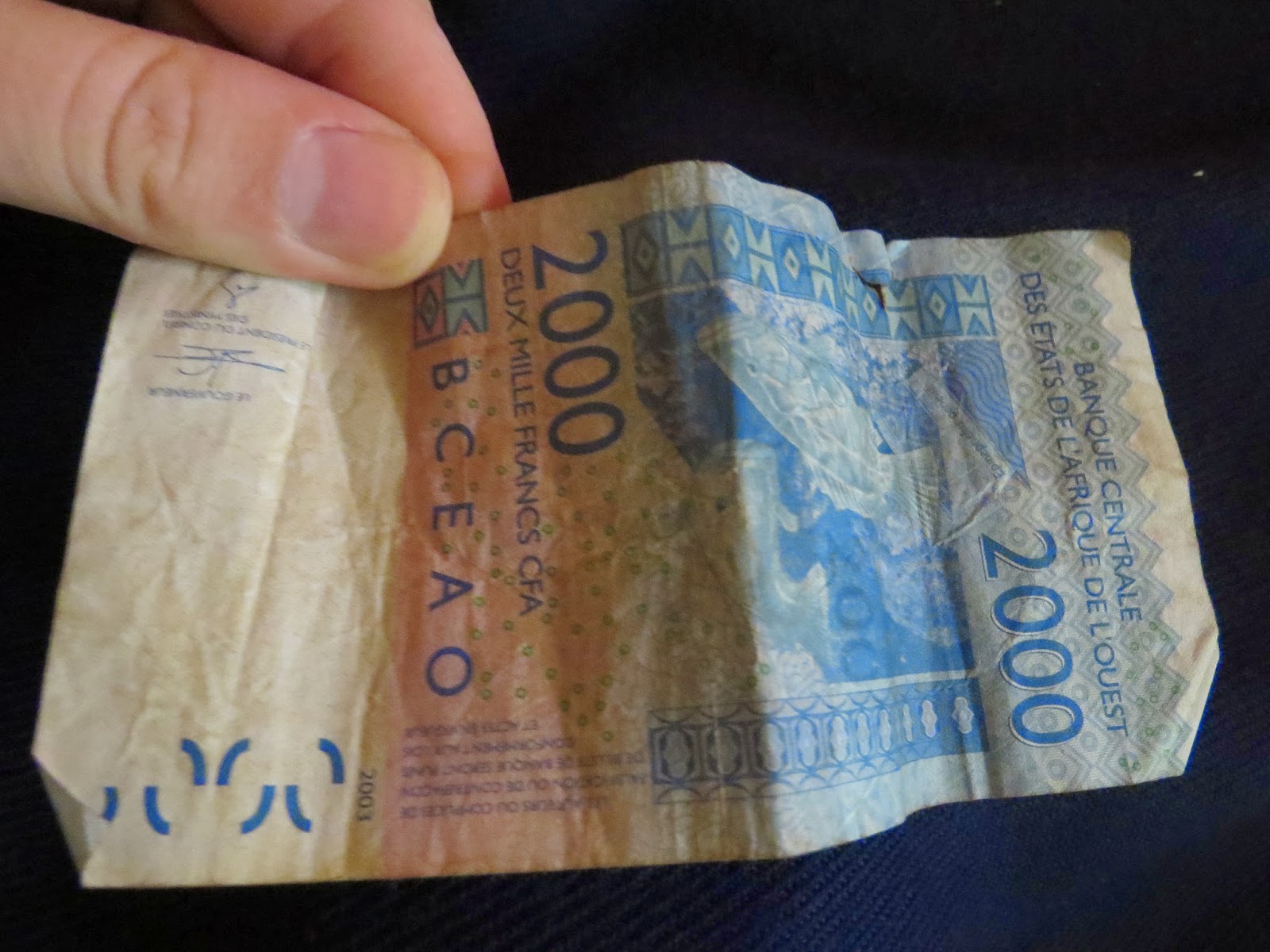Pictures, comments, and updates on my new cultural experiences in Burkina Faso, West Africa.
Tuesday, December 30, 2014
currency
The currency in Burkina Faso is called the Franc CFA. One U.S. dollar is exchanged for around 450 CFA.
Below you see the 1000 CFA. This is the price of a bottle of mango juice.
2000 CFA. The traditional grilled chicken I've mentioned costs 2500 CFA.
The 200 CFA coin can purchase a bar of soap, for example.
The 100 CFA coin can buy an egg. With 50 Francs I can buy a small red onion at the neighbor's produce stand.
500 Francs comes in either a coin or a small bill.
Below is pictured the 25 CFA coin, front and back.
Learning to use a new kind of money. It's also the best way to learn two- and three-digit numbers in French.
Saturday, December 6, 2014
Unfamiliar Household Objects
 Photo Gallery of French Plugs and Outlets
Photo Gallery of French Plugs and OutletsHow many people knew there was anything besides the American plug? I was among those ignorant folks who thought normal to me was normal to everyone. A few months before traveling, I read the blog of an American teacher who came to Burkina Faso. She suggested bringing plug adapters. Oh! Good to know.
Below: An outlet strip that takes both American and French plugs.

Door Rug and Floor Mop
When I want to mop the floor - an occasion that happens about every two days - I grab the cotton rug at the front door or the bathroom door. I was told that Burkinabe housewives often use the water left from dish washing, something I've done as well.
Oh, I notice that I said when I WANT to mop the floor. Maybe I should be slightly more truthful and make that WHEN THE DUST IS MUCH AND WATERMELON JUICE DRIPPED ON THE FLOOR.
The
mornings are cooler, a good thing for this season. The other happy
thing, of course, is that it's coming up on watermelon season!
As for water, I have wondered what that will be like in the coming months. I haven't heard of it being any more of a problem in the dry season than it was in the rainy season; still the same innocent-looking substance.
Here you see one of those large water jugs often seen in the pictures Americans see from Africa.
They really are everyday objects around here (this was one a neighbor loaned us.) Young boys and housewives often pass our house on the way to the fountain around the corner. They push carts loaded with these or a large metal barrel. Sometimes donkeys pull the cart. Or they strap them on either side of a bicycle.
They go, whenever the water runs out. The "Komnaba" (King of Water), as they call him, sells them water at the fountain.
Yesterday I saw a woman biking with full jugs of water. And the water was splashing out of her jugs, because they didn't have caps.
It is a blessing to have running water. Same as everywhere, by every transport, you never know what is in that water.
Left: Blessing to have electricity, too. Light and fan switches.
Okay, so this is acheke. I have no idea how to describe this food. As usual, it is a filling substance; also a nice break from rice. The texture might be described like very large, soft couscous. But the taste cannot be compared with any American/European food. It is made from cassava, if that helps at all. When I wondered, Adama said I wouldn't want to know how it is processed! We steam it well before eating (also because it is sour when not steamed well.)
Often it is eaten with hands, first mixing it in an oil sauce of fish, onion, and tomato.
Left: internet connection key.
When we want to use the internet, we plug in this USB key, which is loaded with a SIM card. Using this method, we must buy units of internet.

It would be good for developing countries to have the vast internet resources more readily and inexpensively available.
Right: When we want to connect, this is the screen that comes up on the computer.
Tea-Time!
When guys (and sometimes ladies) want to spend a quiet afternoon around the charcoal burner, boiling tea, they need this equipment.
2 little teapots - 1 for boiling the tea leaves, one for reheating with sugar.
1 large glass, for mixing with sugar (sometimes it's equal parts sugar and tea)
the tea is VERY bitter
tiny glasses, for slurping a few sips of tea.
The normal procedure is to boil the tea leaves three times, while sitting, while talking.
Happy sitting, talking tea parties to you, too!
Love to all,
Annette
Subscribe to:
Comments (Atom)














